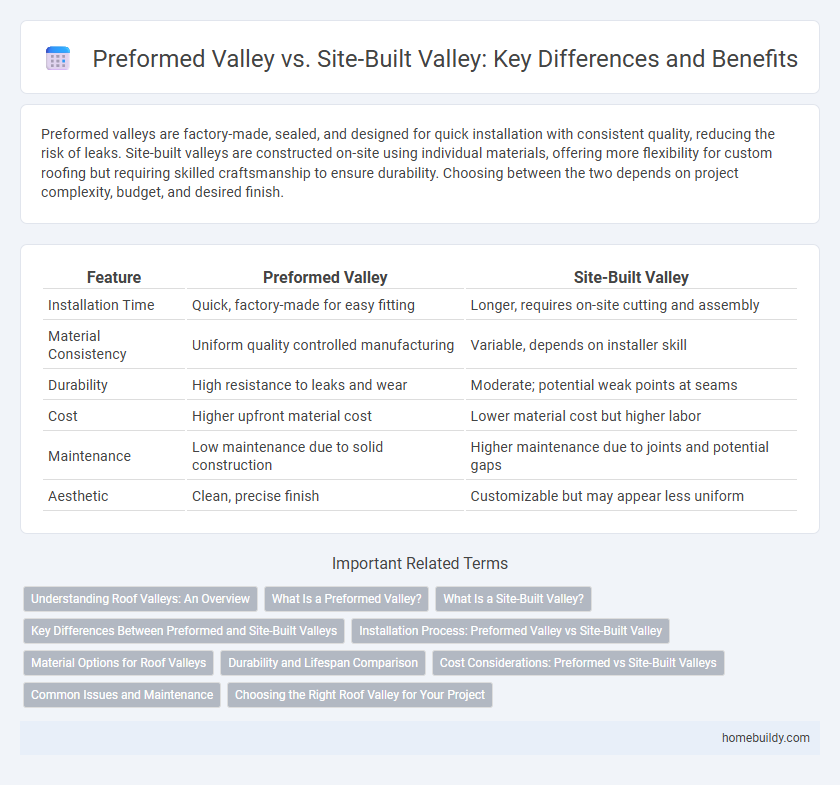Preformed valleys are factory-made, sealed, and designed for quick installation with consistent quality, reducing the risk of leaks. Site-built valleys are constructed on-site using individual materials, offering more flexibility for custom roofing but requiring skilled craftsmanship to ensure durability. Choosing between the two depends on project complexity, budget, and desired finish.
Table of Comparison
| Feature | Preformed Valley | Site-Built Valley |
|---|---|---|
| Installation Time | Quick, factory-made for easy fitting | Longer, requires on-site cutting and assembly |
| Material Consistency | Uniform quality controlled manufacturing | Variable, depends on installer skill |
| Durability | High resistance to leaks and wear | Moderate; potential weak points at seams |
| Cost | Higher upfront material cost | Lower material cost but higher labor |
| Maintenance | Low maintenance due to solid construction | Higher maintenance due to joints and potential gaps |
| Aesthetic | Clean, precise finish | Customizable but may appear less uniform |
Understanding Roof Valleys: An Overview
Preformed valleys consist of factory-made metal or polymer components designed for precise dimensions and enhanced water drainage, reducing the risk of leaks compared to site-built valleys, which are custom-installed on-site using layered roofing materials. Site-built valleys require expert craftsmanship to ensure proper alignment and sealing, while preformed valleys offer consistent quality and faster installation times. Selecting between preformed and site-built valleys impacts the roof's durability, waterproofing efficiency, and maintenance requirements.
What Is a Preformed Valley?
A preformed valley is a pre-manufactured roofing component designed to efficiently channel water through roof valleys, offering consistent dimensions and simplified installation compared to site-built valleys. Made from materials such as galvanized steel or aluminum, preformed valleys provide enhanced durability and improved waterproofing, reducing the risk of leaks commonly associated with manually constructed valleys. Their factory precision ensures optimal fit and performance, minimizing labor time and potential errors during roofing projects.
What Is a Site-Built Valley?
A site-built valley is a roof valley constructed directly on the roofing substrate using individual metal flashing pieces assembled and shaped during installation. This method offers flexibility to accommodate complex valley shapes but requires skilled labor and more time compared to preformed valley flashing. Site-built valleys ensure custom fitting and precise water drainage in traditional or uniquely angled roof designs.
Key Differences Between Preformed and Site-Built Valleys
Preformed valleys are factory-made, ensuring consistent dimensions and superior waterproofing due to integrated materials, whereas site-built valleys are constructed on-site using overlapping shingles which may vary in precision and durability. Preformed valleys typically offer faster installation and reduced labor costs, while site-built valleys allow for more customization to fit unique roof designs. The choice impacts overall roof longevity and leak prevention, with preformed valleys generally favored for their reliability in critical water drainage areas.
Installation Process: Preformed Valley vs Site-Built Valley
Preformed valleys streamline the installation process by offering factory-made components that fit precisely, reducing labor time and minimizing errors. Site-built valleys require manual cutting and fitting of individual shingles or metal pieces, which increases labor intensity and the potential for improper alignment. The consistency of preformed valley installations enhances waterproofing performance compared to the variability inherent in site-built methods.
Material Options for Roof Valleys
Preformed roof valleys are typically made from materials like galvanized steel, aluminum, or copper, offering durability and ease of installation with factory-cut dimensions. Site-built valleys often use the same metals but require on-site cutting and fitting, allowing for customized shapes but potentially increasing labor time and material waste. Both methods must ensure proper corrosion resistance and waterproofing to maintain roof integrity over time.
Durability and Lifespan Comparison
Preformed valleys offer superior durability due to their factory-assembled metal or composite construction, which resists weathering and corrosion better than traditional site-built valleys made from layered shingles or metal flashing. Site-built valleys may require more frequent maintenance and replacement because their materials are more prone to damage from water infiltration and UV exposure. Overall, preformed valleys extend the roof's lifespan by minimizing common failure points, often lasting 30 to 50 years compared to 15 to 25 years for site-built valleys.
Cost Considerations: Preformed vs Site-Built Valleys
Preformed valleys typically reduce labor costs due to faster installation and fewer material wastes compared to site-built valleys, which require precise cutting and fitting on the job site. While preformed options often have higher upfront costs for materials, they offer long-term savings by minimizing potential leak points and maintenance expenses. Site-built valleys may seem economical initially but can incur greater expenses over time from repairs due to improper alignment or water infiltration.
Common Issues and Maintenance
Preformed valleys reduce common issues such as water leakage and shingle damage due to their factory-made precision and integrated waterproof underlayment. Site-built valleys often experience problems with improper alignment and less effective water drainage, leading to increased maintenance needs like frequent sealant replacement and shingle repairs. Regular inspection and timely cleaning of debris are essential for both types to prevent mold growth and prolong roof valley lifespan.
Choosing the Right Roof Valley for Your Project
Preformed valleys offer precise manufacturing standards and consistent performance, reducing installation errors and saving time on complex roof designs. Site-built valleys provide flexibility for custom layouts and unique roof angles, allowing for on-site adjustments that suit specific project needs. Selecting the right roof valley depends on factors like roof complexity, budget constraints, and long-term maintenance considerations.
Preformed valley vs Site-built valley Infographic

 homebuildy.com
homebuildy.com